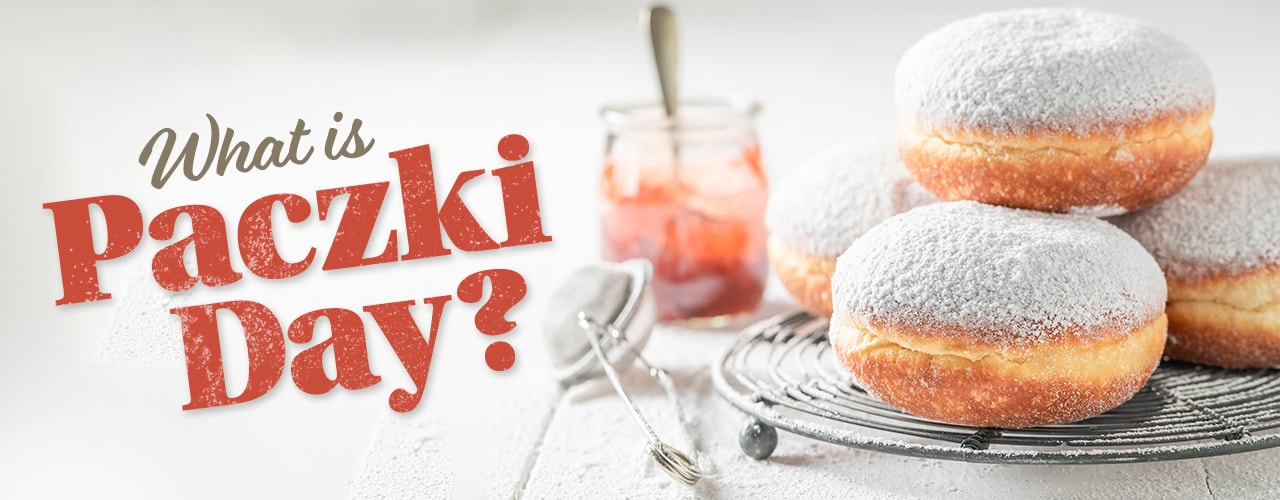While Carnival and Fat Tuesday are celebrated in many different ways worldwide, one festivity, in particular, is especially delicious: Paczki Day. This day celebrates a pillowy, jam-filled Polish pastry, and people excitedly line bakery blocks for a box once every year. But what makes paczki so delicious, and why are they only eaten during one specific time of the year? We’ll get into everything you need to know about Paczki Day and why it should be added to your Fat Tuesday traditions.
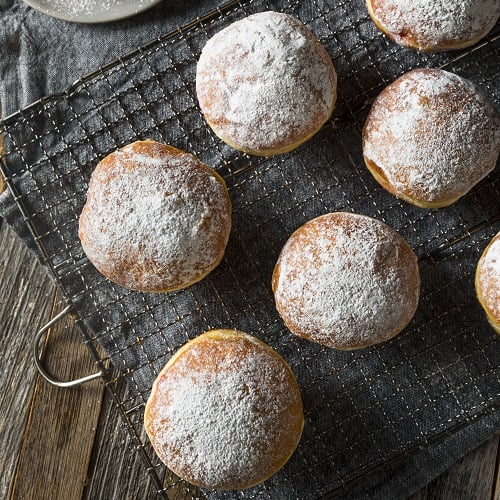
Paczki Pronunciation
Paczki is pronounced as “pohnch-kee” and spelled with an ogonek on the “a” in Polish. Keep in mind that paczki is not pronounced or spelled as "punchkees" as so commonly believed in America. Paczki is the plural form of the word, while the singular form is paczek, which is pronounced “pohnch-eck”.
When Is Paczki Day?
This year, Paczki Day lands on March 4, 2025. Paczki Day in America is on Fat Tuesday, also known as Shrove Tuesday. Fat Tuesday is the day before the start of Lent in the Catholic religion, Ash Wednesday. Fat Tuesday is also the same day as Mardi Gras. In Poland, Paczki Day is more commonly celebrated on Fat Thursday, otherwise known as Tlusty Czwartek. Fat Thursday is the Thursday before Ash Wednesday.
What Is Paczki?
Paczki are spherical, deep-fried balls of dough that are filled with jam, curd, or custard. Once fried to a golden brown, they are traditionally topped with a dusting of powdered sugar, covered in granulated sugar, or enrobed in a clear glaze and topped with diced orange peels.
Paczki Flavors
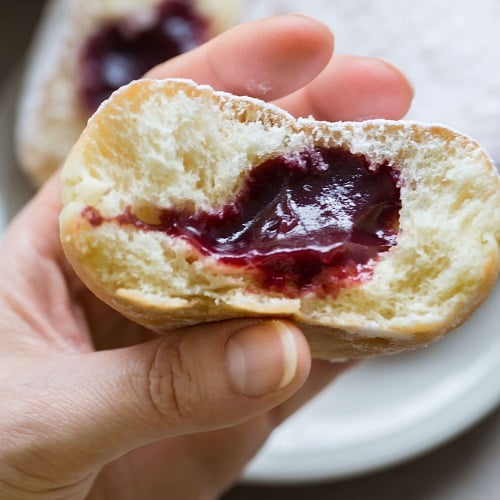
There are traditional paczki filling flavors that have been passed down over time. Here are some of the most popular:
- Rose petal preserves
- Prune
- Lemon curd
- Custard
- Bavarian cream
- Raspberry
- Apple
Polish bakeries in America carry these traditional paczki flavors, and they have also taken creative liberties to pursue different filling ideas to appease American cravings. Unique filling ideas such as caramel turtle, Black Forest, chocolate mocha, cannoli, key lime, chocolate mousse, cookies and cream, peanut butter and jelly, and so much more have been used as paczki fillings to add to the fun of the holiday.
What Are the Main Ingredients in Paczki?
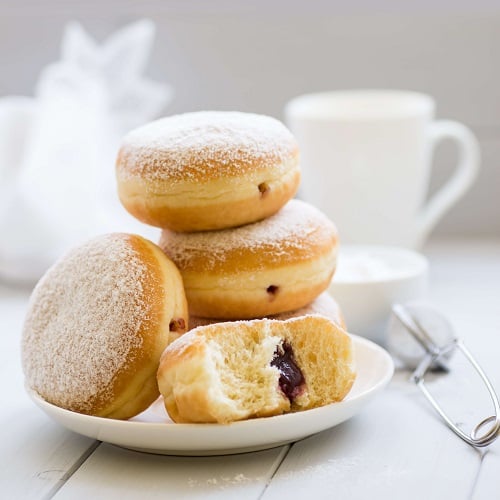
The main ingredients in paczki dough are:
- Yeast
- Grain alcohol
- Eggs
- Flour
- Butter
Paczki were created to use up the last of the forbidden ingredients of Lent, including lard, eggs, fruit, and sugar. While the fat in paczki dough is butter, the dough was traditionally fried in lard to use it up before Lent.
Paczki vs Donuts
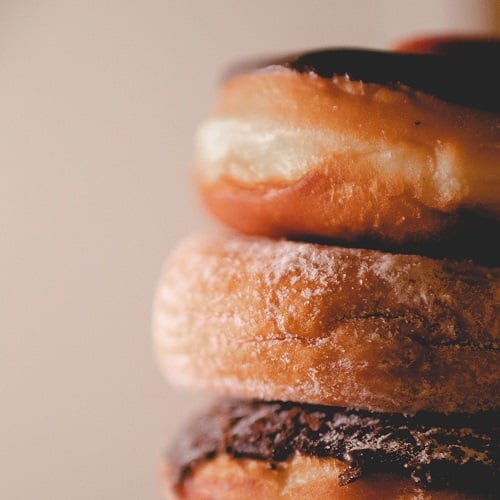
The difference between paczki and donuts is the ingredients in their dough. Paczki uses an extra amount of enriching ingredients, yeast, grain alcohol, and high-gluten flour. Together, these create a richer-than-brioche dough, but far chewier with little to no crumbs. The use of grain alcohol creates a less oily product as well because the grain alcohol evaporates as it fries in the oil, which prevents excess oil absorption in the dough.
Additionally, many types of donuts use cake or pastry flour, smaller amounts of enriching ingredients, and baking soda or baking powder instead of yeast. Therefore, donuts are more crumbly and less rich-tasting than paczki.
Paczki vs Fasnachts
There are similarities and differences between paczki and fastnachts. Although paczki and fastnachts are both eaten on Fat Tuesday, fastnachts are made with potato dough and shaped into a triangle or square, while paczki are made from yeasted dough and are round in shape. Square-shaped fastnachts are meant to represent the four gospels of the Bible, whereas a triangular fastnacht represents the Holy Trinity. A fasnacht's origin is different too: where paczki is from Poland, fastnachts are from Germany. Additionally, fastnachts are not filled like paczki are, but are instead cut horizontally like a bagel, smeared with butter, drizzled with maple syrup, and replaced with the top.
Paczki and fastnachts are both eaten on Fat Tuesday to use up the last of the forbidden ingredients of Lent (lard, sugar, and eggs). After being deep-fried in oil, they’re both commonly dusted with powdered sugar and served to crowds who arrive in droves to take home multiple boxes.
Sufganiyot vs Paczki
The difference between sufganiyot and paczki is the way they are fried. While paczki are fried in lard, sufganiyot are fried in schmaltz (clarified chicken fat) as lard does not follow the kashrut laws of Judaism. Plus, sufganiyot are usually served on Hanukkah, while paczki are saved for Fat Tuesday or Tlusty Czwartek.
Paczki History

The history of paczki goes back to the Middle Ages when carnival season was celebrated in Europe with vibrant colors, bold clothing, and unique events. Carnival is known as the time of indulgence before the fasting season of Lent, which prohibits the consumption of alcohol and meat, and previously prohibited the excessive consumption of certain fats, sugars, and animal products.
As a way to cut down on wasted food before the start of Lent, as well as indulge a bit before six weeks of fasting, paczki were created in Poland. The paczki dough uses everything that was originally forbidden during Lent: alcohol, butter, milk, lard, and eggs. Plus, as excessive sugar was also forbidden, sugar was used in the jam filling as well as on the outside of the paczki.
Paczki Day in Poland
In Poland, Paczki Day is mostly celebrated on Tlusty Czwartek, also known as Fat Thursday. Fat Thursday is the Thursday before Ash Wednesday, which marks the start of the six weeks of Lent. Fat Thursday takes place during Carnival and is a time that Christians indulge in pastries that aren’t normally allowed during the fasting season of Lent.
Paczki Day in America
In America, Paczki Day is mostly celebrated on Fat Tuesday, also known as Mardi Gras. Fat Tuesday is the day before the start of the Lenten season which begins on Ash Wednesday. Paczki Day is commonly celebrated in the Midwestern region of America, most notably Chicago and Detroit, where a large number of Poles immigrated during 1989 and throughout the 1990s. The emigration from Poland brought the delicious paczki pastry, and with that, Paczki Day in America.
Paczki Day has become popular in many communities across the United States, with bakeries and restaurants offering a wide variety of flavors and fillings. Whether you're celebrating your Polish heritage or simply looking for a tasty treat, Paczki Day is a delightful way to satisfy your sweet tooth. Be sure to be first in line to grab a couple of boxes worth before they are gone.
